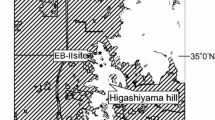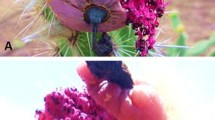Revisiting Camu-camu ( Myrciaria dubia ): Twenty-seven Years of Fruit Collection and Flooding at an Oxbow Lake in Peruvian Amazonia Camu-camu (Myrciaria dubia HBK McVaugh; Myrtaceae) is an important riparian species in the floodplain forests of Peruvian Amazonia, and its fruits have been harvested commercially for over 30 years. We examined the population impacts of intensive fruit collection on this species by remeasuring a 1,000 m2 inventory transect that was established in 1984 in a dense stand of M. dubia along an oxbow lake. We found that regeneration rates had declined notably since the original survey, and that the number of M. dubia individuals had dropped from 693 to 161 genets. While this dramatic shift in population structure would appear to be caused by excessive fruit collection, the same decline in regeneration was noted for Eugenia inundata DC, an associated species of similar growth form and phenology that is not harvested. The life cycles of both species are closely tied to the rise and fall of the river. In addition to annual fruit collection, we suggest that the extreme hydrological events that have occurred in the Amazon Basin over the last few decades, as well as the successional development of the ox-box lake study site that has been slowly filling up with sediment, also play a role in the observed reduction in M. dubia numbers.
Revisitando camu-camu ( Myrciaria dubia ): Veinte y siete años de la recolección de frutos y la inundación en una cocha en la Amazonía peruana Camu-camu (Myrciaria dubia HBK McVaugh; Myrtaceae) es una especie importante en los bosques inundables de la de la Amazonía peruana, y sus frutas han sido cosechados comercialmente por más de 30 años. Examinamos el impacto de la cosecha intensiva de frutas en una población de esta especie por la re- medición de un transecto de inventario de 1,000 m2 que fue establecido en 1984 en un área densa de M. dubia al lado de una cocha meandro. Encontramos que las tasas de de regeneración había disminuido notablemente desde la encuesta original, y que el número de individuos de M. dubia había caído de 693 a 161 ginetas. Aunque este cambio dramático en la estructura de la población parece estar causada por la excesiva recolección de frutas, la misma disminución de la regeneración se observó por Eugenia inundata DC, una especie asociada con forma similar de crecimiento y de fenología pero que no es cosechada. Los ciclos de vida de ambas especies están estrechamente ligados a la subida y bajada del río. Además de la colecta anual de frutas, sugerimos que los fenómenos hidrológicos extremos que se han ocurrido en la cuenca del Amazonas en los últimos decenios, así como el desarrollo sucesional de la cocha de estudio que se ha llenanda lentamente con sedimentos, también fueron responibles por parte de la reducción observada en los números de M. dubia.


Similar content being viewed by others
Literature Cited
Araujo-Lima, C. and M. Goulding. 1997. So fruitful a fish: Ecology, conservation, and aquaculture of the Amazon’s tambaqui. Columbia University Press, New York.
Bellingham, P. J. and A. D. Sparrow. 2000. Resprouting as a life history strategy in woody plant communities. Oikos 89(2):409–416.
Davidson, E., A. C. de Araújo, P. Artaxo, J. K. Balch, I. F. Brown, M. M. C. Bustamante, M. T. Coe, R. S. DeFries, M. Keller, M. Longo, J. W. Munger, W. Schroeder, B. R. S. Soares-Filho, C. M. Souza, and S. C. Wofsy. 2012. The Amazon basin in transition. Nature 481:321–328.
Espinoza, J. C., J.-L. Guyot, J. Ronchail, G. Cochonneau, N. Filizola, P. Fraizy, E. de Oliveira, J. Ordoñez, and P. Vauchel. 2009. Contrasting regional discharge evolutions in the Amazon basin (1974–2004). Journal of Hydrology 325:297–311.
———, J. Ronchail, J.-L. Guyot, C. Junquas, G. Drapeau, J. M. Martinez, W. Santini, P. Vauchel, W. Lavado, J. Ordoñez, and R. Espinoza. 2012. From drought to flooding: Understanding the abrupt 2010–11 hydrological annual cycle in the Amazonas River and tributaries. Environmental Research Letters 7:024008.
Ferreyra, R. 1971. Camu camu, nueva fuente de vitamina C. Boletin Experimental Agropecuaria 7(4):28.
Junk, W. J., P. B. Bayley, and R. E. Sparks. 1989. The flood pulse concept in river-floodplain systems. In: Proceedings of the International Large River Symposium, ed. D. P. Dodge. Canadian Special Publication of Fisheries and Aquatic Science 106:110–127.
Leak, W. B. 1965. The J-shaped probability distribution. Forest Science 11:405–419.
Marengo, J. A., C. A. Nobre, J. Tomasella, M. Oyama, G. Sampaio, H. Camargo, and L. M. Alves. 2008. The drought of Amazonia in 2005. Journal of Climate 21:495–516.
———, J. Tomasella, W. R. Soares, L. M. Alves, and C. Nobre. 2012. Extreme climatic events in the Amazon basin. Theoretical and Applied Climatology 107:73–85.
McVaugh, R. 1963. Tropical American Myrtaceae, II. Field Museum of Natural History Botany Series 29:501–502.
Penn, J. W. 2004. Another boom for Amazonia? Examining the socioeconomic and environmental implications of the new camu camu industry in Peru. Dissertation.com, University of Florida, Boca Raton.
——— 2006. The cultivation of camu camu (Myrciaria dubia): A tree planting programme in the Peruvian Amazon. Forests, Trees and Livelihoods 16:85–101.
Peres, C. A., C. Baider, P. A. Zuidema, L. H. O. Wadt, K. A. Kainer, D. A. P. Gomes-Silva, R. P. Salomão, L. L. Simões, E. R. N. Franciosi, F. C. Valverde, R. Gribel, G. H. Shepard Jr., M. Kanashiro, P. Coventry, D. W. Yu, A. R. Watkinson, and R. P. Freckleton. 2003. Demographic threats to the sustainabliliy of Brazil nut exploitation. Science 302:2112–2114.
Peters, C. M. 1996. The ecology and management of non-timber forest resources. World Bank, Washington, D.C. Technical Paper 322.
———, M. J. Balick, F. Kahn, and A. B. Anderson. 1989. Oligarchic forests of economic plants in Amazonia: Utilization and conservation of an important tropical resource. Conservation Biology 3(4):341–349.
——— and E. J. Hammond. 1990. Fruits from the flooded forests of Peruvian Amazonia: Yield estimates for natural populations of three promising species. Advances in Economic Botany 8:159–176.
Pinedo, P. M., V. C. Delgado, P. R. Farroñay, T. D. Del Castillo, C. S. Iman, V. J. Villacrés, M. L. Faching, C. C. Oiva, R. C. Abanto, L. R. Bardales, and V. R. Vega. 2010. Camu Camu (Myrciaria dubia, Myrtaceae) Aportes para su aprovechamiento sostenible en la Amazonía peruana. Instituto de Investigaciones de la Amazonía Peruana, PROBOSQUES.
R Development Core Team. 2010. R: A language and environment for statistical computing. Vienna, Austria: R Foundation for Statistical Computing. http://www.R-project.org/.
Rowland, J. C., K. Lepper, W. E. Dietrich, C. J. Wilson, and R. Sheldon. 2005. Tie channel sedimentation rates, oxbow formation age and channel migration rate from optically stimulated luminescence (OSL) analysis of floodplain deposits. Earth Surface Processes and Landforms 30:1161–1179.
Salo, J., R. Kalliola, I. Häkkinen, Y. Mäkinen, P. Niemelä, M. Puhakka, and P. D. Coley. 1986. River dynamics and the diversity of Amazon lowland forest. Nature 322:254–258.
SCBD. 2001. Sustainable management of non-timber forest resources. CBD Technical Series 6. Secretariat of the Convention on Biological Diversity, Montreal, Canada.
Stanley, R., R. Voeks, and L. Short. 2012. Is non-timber forest product harvest sustainable in the less developed world? A systematic review of the recent economic and ecological literature. Ethnobiology and Conservation 1:1–39.
Ticktin, T. 2004. The ecological implications of harvesting non-timber forest products. Journal of Applied Ecology 41(1):11–21.
——— and C. Shackleton. 2011. Harvesting non-timber forest products sustainably: Opportunities and challenges. Pages 149–169 in S. Shackleton, C. Shackleton, and P. Shanley, eds., Non-timber forest products in the global context. Springer-Verlag, Berlin.
Acknowledgments
We are especially grateful to research assistants H. Pacaya, A. Pacaya, and H. Haas. Thanks to Harmless Harvest and the Tropical Research Institute for funding, and to the Instituto de Investigaciones de la Amazonía Peruana (IIAP) for their support.
Author information
Authors and Affiliations
Corresponding author
Rights and permissions
About this article
Cite this article
Martin, M.P., Peters, C.M. & Ashton, M.S. Revisiting Camu-camu (Myrciaria dubia): Twenty-seven Years of Fruit Collection and Flooding at an Oxbow Lake in Peruvian Amazonia. Econ Bot 68, 169–176 (2014). https://doi.org/10.1007/s12231-014-9269-4
Received:
Accepted:
Published:
Issue Date:
DOI: https://doi.org/10.1007/s12231-014-9269-4




